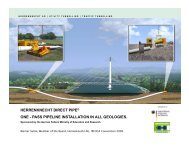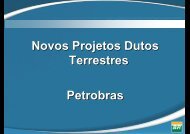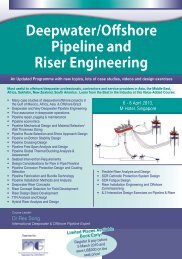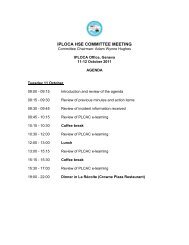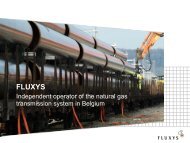Carbon Footprint of Pipeline Projects - IPLOCA.com
Carbon Footprint of Pipeline Projects - IPLOCA.com
Carbon Footprint of Pipeline Projects - IPLOCA.com
- No tags were found...
Create successful ePaper yourself
Turn your PDF publications into a flip-book with our unique Google optimized e-Paper software.
<strong>Carbon</strong> <strong>Footprint</strong> <strong>of</strong> <strong>Pipeline</strong> <strong>Projects</strong>44 th Annual <strong>IPLOCA</strong> Convention, Venice27 September - 1 October 20101
<strong>Carbon</strong> <strong>Footprint</strong> <strong>of</strong> <strong>Pipeline</strong> <strong>Projects</strong>How does Nacap decrease the emission <strong>of</strong> carbon dioxidewhile bringing energy to its destination?2
<strong>Carbon</strong> <strong>Footprint</strong> <strong>of</strong> <strong>Pipeline</strong> ConstructionDefinition“The <strong>Carbon</strong> <strong>Footprint</strong> is a measure <strong>of</strong>the exclusive amount <strong>of</strong> carbon dioxideemission that is directly and indirectlycaused by an activity”3
<strong>Carbon</strong> <strong>Footprint</strong> <strong>of</strong> <strong>Pipeline</strong> ConstructionWhy?<strong>Carbon</strong> footprint is estimated in order to find out the environmental impact <strong>of</strong>executing pipeline projects.The out<strong>com</strong>e is useful both for Nacap, in order to <strong>of</strong>fset the emissions andreduce energy consumption (costs), as well as for clients who may wish toconsider the results in their decision making process.Except for some research on CO 2 emission for the production <strong>of</strong> certain types<strong>of</strong> steel and plastic used in the pipeline industry, no in-depth research has beenexecuted for CO 2 emissions <strong>of</strong> pipeline construction in the past.4
<strong>Carbon</strong> <strong>Footprint</strong> <strong>of</strong> <strong>Pipeline</strong> ConstructionHow is it calculated?This research is based on five different pipeline diameters:16, 20, 24, 36 and 48 inch diameter.This approach is chosen in order to show the difference in emissions perdiameter and to establish a trend line for understanding the emission behaviortowards pipeline projects <strong>of</strong> different diameters.The specific diameters were chosen because <strong>of</strong> their <strong>com</strong>mon occurrence inprojects.5
<strong>Carbon</strong> <strong>Footprint</strong> <strong>of</strong> <strong>Pipeline</strong> ConstructionSteel pipe production emissionThe production process <strong>of</strong> the pipes is by far the largest emitter <strong>of</strong>carbon dioxide in the carbon footprint <strong>of</strong> pipeline projects. It requiressignificant energy to convert raw material into steel pipes.6
<strong>Carbon</strong> <strong>Footprint</strong> <strong>of</strong> <strong>Pipeline</strong> ConstructionTransportation emissionThe transportation <strong>of</strong> various diameter line pipes over 1,000 kilometersis given in kilograms CO 2 whereby 1,000 km are taken as an average.This <strong>com</strong>ponent only concentrates on the heavy transportation <strong>of</strong>pipeline projects. The transportation <strong>of</strong> personnel and business flightsis included in the overhead.7
<strong>Carbon</strong> <strong>Footprint</strong> <strong>of</strong> <strong>Pipeline</strong> ConstructionEquipment fuel usage emissionThe equipment used during pipeline construction is an importantcontributor <strong>of</strong> the total emission during a pipeline project.The equipment is grouped into five separate equipment sections:the earth moving equipment, heavy lifting equipment, typical pipelineequipment, transportation equipment and others (<strong>com</strong>pressors, pumpsetc.).8
<strong>Carbon</strong> <strong>Footprint</strong> <strong>of</strong> <strong>Pipeline</strong> ConstructionWelding, coating and miscellaneousThe group “others” consists <strong>of</strong> consumables or small equipment whichare consumed, destroyed, wasted and or spent during theproduction/execution period <strong>of</strong> a pipeline project. Nacap focuses onthe welding consumables and coating material used during pipelineconstruction.9
<strong>Carbon</strong> <strong>Footprint</strong> <strong>of</strong> <strong>Pipeline</strong> ConstructionFacilities and overheadThe emission caused by overhead consists out <strong>of</strong> business flights,transportation <strong>of</strong> personnel working in 8 different regional <strong>of</strong>ficesand on construction sites as well as the emission caused by thefacilities.10
<strong>Carbon</strong> <strong>Footprint</strong> <strong>of</strong> <strong>Pipeline</strong> <strong>Projects</strong>Overview14001200tons CO2 per km pipeline1000800600400OverheadCoating & weldingEquipment fuel usageTransport (1000 km)Steel production & pipe rolling200016 20 24 36 48Pipe diameter (inch)11
<strong>Carbon</strong> <strong>Footprint</strong> <strong>of</strong> <strong>Pipeline</strong> <strong>Projects</strong>Steel pipe productionDiameter(inch)Thickness(mm)Weight(ton/kmpipe)Blast furnaceCO 2 emission (ton/km pipe)ContinuouscastingRolling &pipeproduction16 7.95 77.9 120.7 1.1 11.9 133.720 9.82 120.3 186.4 1.7 18.4 206.424 10.25 150.6 233.5 2.1 23.0 258.636 14.35 316.3 490.3 4.4 48.3 543.048 19.30 567.2 879.2 7.9 86.7 973.7CO 2 emission for steel pipe productionTotalThe carbon steel for pipes used in the pipeline industry is produced in blastfurnaces. This process consumes a huge amount <strong>of</strong> energy.12
<strong>Carbon</strong> <strong>Footprint</strong> <strong>of</strong> <strong>Pipeline</strong> <strong>Projects</strong>Steel pipe productionOne <strong>of</strong> the major <strong>com</strong>ponents in the amount <strong>of</strong> CO 2 emission throughoutthe process is the production <strong>of</strong> steel pipes, a process pipeline constructioncontractors cannot influence.13
<strong>Carbon</strong> <strong>Footprint</strong> <strong>of</strong> <strong>Pipeline</strong> <strong>Projects</strong>How does Nacap contributeto the reduction <strong>of</strong>CO 2 emission?14
<strong>Carbon</strong> <strong>Footprint</strong> <strong>of</strong> <strong>Pipeline</strong> <strong>Projects</strong>Contribution by NacapThe areas in which Nacap has influence on reduction <strong>of</strong> CO 2 emission are:- Selection and use <strong>of</strong> heavy equipment;- Transportation <strong>of</strong> the pipes;- Welding and coating process; and- Transportation <strong>of</strong> equipment and personal (overhead).15
<strong>Carbon</strong> <strong>Footprint</strong> <strong>of</strong> <strong>Pipeline</strong> <strong>Projects</strong>Transportation• The transportation activity is divided into two different parts; equipment and pipes.• The calculation <strong>of</strong> transportation emission is based on an average <strong>of</strong> 100 grams <strong>of</strong>CO 2 per ton/km for the <strong>com</strong>bination <strong>of</strong> boat, rail and road transportation.• The weight <strong>of</strong> pipes to be transported depends on the pipe thickness.• The weight <strong>of</strong> equipment per km pipe was calculated by dividing a ‘typical’ spread fora certain diameter by a ‘typical’ project length.Weight (ton/km pipe)CO 2 Emission (ton/km pipe)Diameter(inch) Pipes Equipment Pipe transportEquipmenttransportTotal16 77.9 16.8 7.79 2.07 9.8520 120.3 32.0 12.03 3.94 15.9624 150.6 58.7 15.06 7.22 22.2836 316.3 139.2 31.63 17.12 48.7548 567.2 234.7 56.72 28.86 85.5916
<strong>Carbon</strong> <strong>Footprint</strong> <strong>of</strong> <strong>Pipeline</strong> <strong>Projects</strong>TransportationThe previous table shows the difference between the transportation <strong>of</strong> equipment and thetransportation <strong>of</strong> pipes. Equipment is in most cases <strong>com</strong>parable in weight to a truckload full<strong>of</strong> pipes, but equipment is used over a much longer stretch.The table shows an almost linear growth <strong>of</strong> the transportation activities.The larger the diameter the more equipment is required to lay a pipeline. The weight <strong>of</strong> thepipelines with similar thickness is also more or less linear in their emission.17
<strong>Carbon</strong> <strong>Footprint</strong> <strong>of</strong> <strong>Pipeline</strong> <strong>Projects</strong>EquipmentCO 2 emissions (ton/km pipe)Diameter(inch)EarthmovingequipmentHeavy liftingequipment<strong>Pipeline</strong>equipmentTransportequipmentOtherequipmentTotal16 27.8 1.3 3.4 15.9 3.3 49.220 24.2 10.5 11.2 3.4 4.3 53.424 37.3 5.5 7.4 6.5 27.3 84.036 54.1 25.5 14.6 18.0 7.6 119.748 68.6 25.8 10.8 24.9 8.5 138.6CO 2 emissions <strong>of</strong> different type <strong>of</strong> equipment• The equipment used during pipeline construction is an important contributor to thetotal emission. The equipment is grouped into five separate equipment sections.• The table illustrates the emission <strong>of</strong> the equipment. The emission is calculated bymultiplying the equipment fuel usage by the CO 2 conversion factor for diesel.18
<strong>Carbon</strong> <strong>Footprint</strong> <strong>of</strong> <strong>Pipeline</strong> <strong>Projects</strong>Equipment140CO2 emissions (ton/km pipe)12010080604020Other equipmentTransport equipment<strong>Pipeline</strong> equipmentHeavy lifting equipmentEarth moving equipment016 20 24 36 48Pipe diameterCO 2 emission for different types <strong>of</strong> equipment is based on the fuelconsumption on real projects.19
<strong>Carbon</strong> <strong>Footprint</strong> <strong>of</strong> <strong>Pipeline</strong> <strong>Projects</strong>EquipmentThe previous chart highlights the difference in emissions between a 24” and a 36” pipelinebeing higher than emission between 36” and 48”, while their difference in diameter is thesame (12”). The explanation is the usage <strong>of</strong> heavy lifting material. For instance,pipeline projects below a 30” diameter use less side-booms in terms <strong>of</strong> hours and fuel usage.However the largest emitter group within the equipment section is the earth movingequipment due to the high fuel consumption required to move large amounts <strong>of</strong> soil tolay the pipeline.20
<strong>Carbon</strong> <strong>Footprint</strong> <strong>of</strong> <strong>Pipeline</strong> <strong>Projects</strong>Welding & coatingUse <strong>of</strong> welding consumables & pipe coating• The use <strong>of</strong> welding consumables hardly has any impact. The electricity used for thewelding is produced by generators, <strong>of</strong> which the fuel consumption is taken intoaccount under ‘equipment’.• The application <strong>of</strong> pipeline coating has a substantial impact on the total footprint.To produce one ton <strong>of</strong> polypropylene and polyethylene, 1.7 tons <strong>of</strong> CO 2 is emitted.Weight (ton/km)CO 2 emissions (ton/km pipe)Dia (inch) Coating Electrodes Coating Electrodes Total16 4.0 0.04 6.8 0.06 6.920 5.0 0.07 8.5 0.12 8.624 6.0 0.09 10.2 0.16 10.436 9.0 0.27 15.3 0.47 15.848 12.0 0.66 20.4 1.13 21.521
<strong>Carbon</strong> <strong>Footprint</strong> <strong>of</strong> <strong>Pipeline</strong> <strong>Projects</strong>OverheadCO 2 emission by overhead is based on business flights, personnelcar transportation and facilities.22
<strong>Carbon</strong> <strong>Footprint</strong> <strong>of</strong> <strong>Pipeline</strong> <strong>Projects</strong>Overhead• The emission from facilities is based on an average <strong>of</strong>fice and extrapolated to thetotal number <strong>of</strong> buildings. The Nacap head <strong>of</strong>fice emits an average <strong>of</strong> 121 tons <strong>of</strong>CO 2 annually.• The emission from business flights is based on flights for Nacap Head Office andextrapolated to the total organization. In 2008, Nacap Headquarters booked morethan 600 flights which led to 342 tons <strong>of</strong> CO 2 emissions.• The emission from traveling by road are based on the total number <strong>of</strong> employees andthe average traveling distance. The table shows that the transportation <strong>of</strong> personnelis by far the largest emitter within the overhead activities.CO 2 emissions (ton/km pipe)Facilities Flights Cars TotalCO 2 total (ton) 967 1,368 14,400 17,701per km pipe 2.4 3.3 35.0 40.723
<strong>Carbon</strong> <strong>Footprint</strong> <strong>of</strong> <strong>Pipeline</strong> <strong>Projects</strong>Results1 KMThe amount <strong>of</strong> CO 2 produced by constructing 1 km <strong>of</strong> 48” pipeline is similar tothe amount <strong>of</strong> CO 2 caused by burning the gas that is stored under 80 bar in7.3 km <strong>of</strong> the same pipeline.Despite the fact that the majority <strong>of</strong> the emission is caused by the steel pipeproduction, the results give the construction industry valuable insights.24
<strong>Carbon</strong> <strong>Footprint</strong> <strong>of</strong> <strong>Pipeline</strong> <strong>Projects</strong>ResultsDiameter(inch)Steelproduction& piperollingTransport(1000 km)CO 2 emissions (ton/km pipe)Equipmentfuel usageCoating &welding Overhead Total16 133.7 9.85 49.2 6.9 40.7 240.420 206.4 15.96 53.4 8.6 40.7 325.124 258.6 22.28 84.0 10.4 40.7 415.936 543.0 48.75 119.7 15.8 40.7 768.048 973.7 85.59 138.6 21.5 40.7 1,260.1Total CO 2 emissions for laying a pipelineThe above table shows the total CO 2 emission for the construction <strong>of</strong> 1 kmpipeline <strong>of</strong> several diameters (based on the assumptions given).25
<strong>Carbon</strong> <strong>Footprint</strong> <strong>of</strong> <strong>Pipeline</strong> <strong>Projects</strong><strong>Pipeline</strong> CO 2 emissionHow to calculate CO 2 emission <strong>of</strong> a pipeline project?www.nacap.<strong>com</strong>: <strong>Pipeline</strong> carbon footprint calculator26
<strong>Carbon</strong> <strong>Footprint</strong> <strong>of</strong> <strong>Pipeline</strong> <strong>Projects</strong>Typical 48” <strong>Pipeline</strong> ProjectHow does Nacap decrease the emission <strong>of</strong> carbon dioxide while bringingenergy to its destination?- Use <strong>of</strong> new sidebooms and paywelders <strong>com</strong>pared to old models from the 90'sreducing fuel consumption by up to 40%;- Efficient transportation and just-in-time delivery <strong>of</strong> line pipes resulting in reductionby 10%;- Use <strong>of</strong> coating process with Stopaq method and new happy happer reduced energyconsumption by 5%;- Mostly local staff is hired on projects, reducing travelling by 30%.27
We bring energy to its destination28





